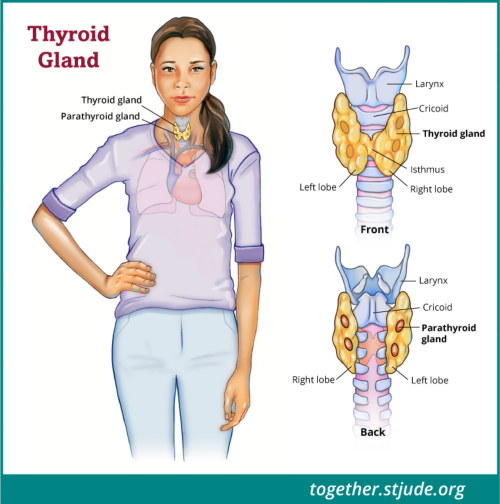Thyroid Nodules and Cancer
What are thyroid nodules and thyroid cancer?
Thyroid nodules are lumps of abnormal cells that grow in the thyroid gland. Most thyroid nodules are benign. This means they are not cancerous.
Thyroid cancer, also called thyroid carcinoma, is rare in children and teens. About 2% of thyroid cancers in the U.S. occur in people under age 20. About 25% of thyroid nodules found in children and teens are cancerous (malignant).
The thyroid gland is a butterfly-shaped organ located at the base of the throat in the front of the neck. It has 2 lobes: 1 on the right and 1 on the left.
The thyroid gland is part of the body's endocrine system. It makes the hormones triiodothyronine (T3) and thyroxine (T4). These hormones control body functions such as temperature, appetite, growth, and energy level. A hormone made in the brain called thyroid-stimulating hormone (TSH) controls T3 and T4 blood levels.
The thyroid makes T3 and T4 hormones using iodine from the diet and a thyroid protein called thyroglobulin (Tg). Both healthy and cancerous thyroid tissue make this thyroglobulin protein. Doctors can monitor the level of thyroglobulin in the blood to find any new thyroid cancer after treatment.
Symptoms of thyroid cancer
Thyroid cancers may not show any symptoms. The doctor may find this cancer during a routine physical exam. Usually, a healthy thyroid is difficult to feel through the skin. Thyroid cancer may appear as a lump in the thyroid gland or swelling in the neck. Rarely, your child might have:
- Breathing problems
- Problems swallowing or pain when swallowing
- Hoarseness
Risk factors for thyroid cancer
Risk factors for childhood thyroid cancer include:
- Exposure to large amounts of high-energy radiation (known as ionizing radiation)
- A genetic predisposition passed down from the parents, such as the condition multiple endocrine neoplasia type 2 (MEN2).
Diagnosis of thyroid cancer
Depending on the type of thyroid cancer, a doctor may diagnose it using:
- A physical exam and health history of the patient and family members
- Blood tests
- Imaging tests, such as ultrasound, CT scan, MRI, or dotatate scan
- Biopsy of the tumor
Several types of thyroid cancer occur in children:
- Differentiated thyroid cancer (DTC) cells appear more normal and grow slowly. There are 2 kinds of DTC:
- Papillary thyroid cancer is the most common. It makes up about 90% of pediatric thyroid cancers.
- Follicular thyroid cancer
- Medullary thyroid cancer (MTC) is a type of neuroendocrine tumor, which starts in the thyroid’s parafollicular cells. These cells make a hormone called calcitonin. Often, MTC is passed down through families.
Treatment of thyroid cancer
Surgery to remove the thyroid gland is known as a thyroidectomy and is the standard treatment. Children with thyroid cancer have a 95% chance of survival.
Treatments for DTC are similar and may include:
- Surgery
- Targeted therapies
- For intermediate to high-risk patients, treatment with 131I radioactive iodine.
MTC starts in a group of thyroid cells that produce hormones. This can affect body functions. Doctors treat this cancer differently than other thyroid cancers. Patients may receive surgery and targeted therapies.
Key points
- Thyroid cancer is rare in children and teens.
- The thyroid gland makes hormones that control body functions such as temperature, appetite, growth, and energy levels.
- There are 3 kinds of thyroid cancer found in children: papillary, follicular, and medullary.
- Your child's treatment depends on the type of cancer.
—
Reviewed: December 2022

